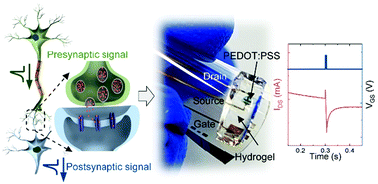A high endurance, temperature-resilient, and robust organic electrochemical transistor for neuromorphic circuits†
Abstract
Artificial synapses, combining sensing and computing functions, have played an important role in emerging human-like sensory systems. In particular, organic electrochemical transistors (OECTs) are highly sought as promising candidates because they possess high transconductance, flexibility, physiological compatibility, and low operating voltage. However, high-performance and long-term stable OECTs that can be integrated with complex circuits are still missing. Here, a hydrogel-based electrochemical transistor (HECT) is proposed by using a dual-network hydrogel as the electrolyte. Given the prominent performance of the hydrogel, including its nondrying, anti-freezing, and self-healing properties, the engineered HECT exhibits long-term stability for more than 4 months, a wide operating temperature of as low as −30 °C, and robustness against damage. In addition, as the HECT can successfully mimic diverse synaptic functions, an optoelectronic neuromorphic circuit is realized by coupling the designed transistor with an optical sensor. The neuromorphic circuit can output an adjustable image depending on different triggering light. Importantly, the proposed transistor can be integrated with various kinds of sensors, providing a promising strategy for the development of future neuromorphic electronics.

- This article is part of the themed collection: Journal of Materials Chemistry C Emerging Investigators


 Please wait while we load your content...
Please wait while we load your content...